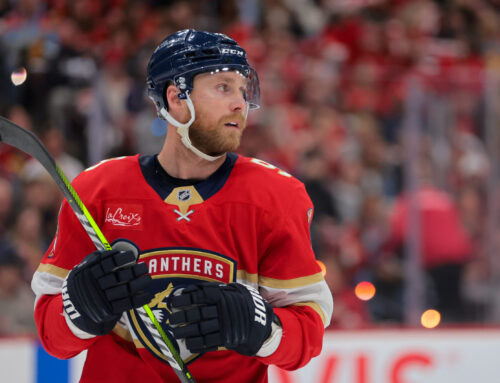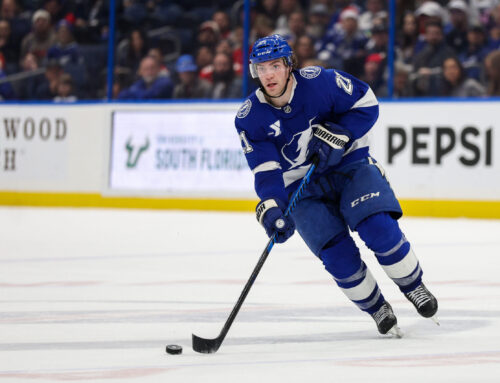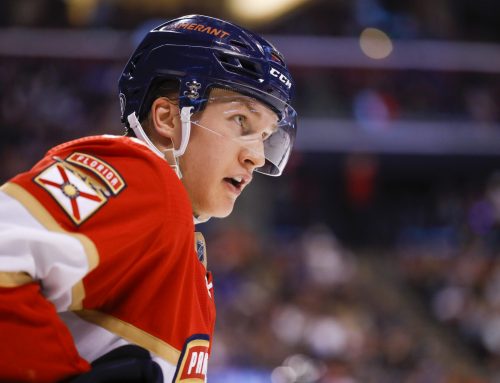
In writing this column, I aim to avoid doing rematches since for the most part circumstances (and, therefore, conclusions) tend to be similar despite the passage of time. But every so often a battle is prime for a redo, like this week when I revisit a February 2016 match between Johnny Gaudreau and Taylor Hall. Why them, and why now? For one, both were among the top fantasy wingers last season, plus Hall has since changed teams and Gaudreau has doubled his NHL experience. What will the data tell us this time around? Let’s find out – cage match starts now.
Career Path and Contract Status
Gaudreau, who turns 25 this summer, was drafted 104th overall in 2011 and opted to play three years of college hockey, culminating in an 80-point in 40-game Hobey Baker award-winning season in 2013-14. In his first two Calgary campaigns Gaudreau appeared to be on the fast track to stardom, posting 64 points in 80 games, then 78 in 79 contests. But he took a bit of a step backwards in 2016-17, managing only 61 points in 72 games although he finished strong with 28 points in his final 30 contests, perhaps providing a clue to his “magical fourth year” breakout of this past season where he set career highs in assists (60) and points (84) and had two separate stretches of 30+ points in two months.
Hall, 26, was the first overall selection in the 2010 entry draft and immediately became a full-time NHLer. After two seasons of decent output but some missed time due to injury, Hall exploded with 50 points in just 45 games in 2012-13, then 80 in 75 games in 2013-14, showing signs he was a top player in real and fantasy hockey. Yet from there his injury issues recurred and he managed only 103 points in 135 games over the next two seasons. Between that and the glut of forwards on Edmonton’s roster, it was a bit less of a shock to see Hall traded in the 2016 offseason. In New Jersey, he produced a decent 53 points in 72 games for 2016-17 on a team that was arguably as bad – if not worse – on paper as some of his previous Oiler squads. Although expectations for Hall were higher for 2017-18, with a season on his new team under his belt and improved squad taking the ice, no one could’ve seen what was coming, namely 93 points in 76 games and his apparent emergence as a bona fide superstar.
Gaudreau is set to count $6.75M against the cap until becomes a UFA after the 2022-23 campaign, while Hall has a slightly lower cap hit ($6M) but will reach the UFA market two years earlier.
Ice Time
|
Season |
Total Ice Time per game (rank among team’s forwards) |
PP Ice Time per game (rank among team’s forwards) |
SH Ice Time per game (rank among team’s forwards) |
|
2017-18 |
19:25 (J.G.) – 1st 19:09 (T.H.) – 1st |
3:32 (J.G.) – 2nd 2:54 (T.H.) – 1st (tied) |
0:01 (J.G.) – 12th 0:06 (T.H.) – 11th (tied) |
|
2016-17 |
18:29 (J.G.) – 1st 19:20 (T.H.) – 2nd |
3:13 (J.G.) – 1st 2:46 (T.H.) – 1st |
0:01 (J.G.) – 12th (tied) 0:17 (T.H.) – 12th |
|
2015-16 |
19:56 (J.G.) – 1st 19:12 (T.H.) – 1st |
3:36 (J.G.) – 1st 2:49 (T.H.) – 2nd |
0:04 (J.G.) – 13th (tied) 0:03 (T.H.) – 13th (tied) |
|
2014-15 |
17:43 (J.G.) – 4th 19:13 (T.H.) – 2nd |
2:48 (J.G.) – 3rd 2:30 (T.H.) – 4th |
0:00 (J.G.) 0:15 (T.H.) – 10th |
For a 93-point season, I’d have expected higher ice time from Hall. And guess what – my instinct is supported by past data, as it turns our only four of the 89 instances of 90+ point scoring since 2000-01 were accomplished with less overall time on ice for the season than what Hall received in 2017-18, and the most recent of the four occurred back in 2006-07. Beyond that, of the 20 total instances of 90+ point scorers since 2010-11, none averaged less power-play time per game than Hall, with the vast majority being at 3:30+ per game.
We’ll look at luck metrics below, but already Hall’s 2017-18 output looks like it could well have been a luck-induced outlier. Or could that be a knee-jerk reaction? After all, in many cases the 85 players who had more TOI than Hall while scoring 90+ points since 2000-01 were also saddled with some shorthanded duty, in which case Hall’s 19 minutes per game of non-shorthanded duty might be more than enough to justify his output. Moreover, if indeed he scored higher than he should’ve in view of his ice time, there’s always the chance he’ll see his ice time improve, since it’s far from maxed out. In short, worries about him having done better than his ice time should have merited could be curable with more ice time, which he just might be in line to receive in future seasons.
In Gaudreau’s case, there’s less left to guesswork/explanation, as his scoring aligns more clearly with his ice time – that is, his two best statistical seasons were indeed those in which he received the most total and power-play ice time. Also, like Hall it’s conceivable Gaudreau could still see even more ice time; however, even if he doesn’t, the non-shorthanded minutes he’s receiving now are more than enough to support a case for him being a point per game player on an ongoing basis.
Secondary Categories
|
Season |
PIMs (per game) |
Hits (per game) |
Blocked Shots (per game) |
Shots (per game) |
PP Points (per game) |
|
0.32 (J.G.) 0.44 (T.H.) |
0.20 (J.G.) 0.94 (T.H.) |
0.22 (J.G.) 0.58 (T.H.) |
2.83 (J.G.) 3.65 (T.H.) |
0.30 (J.G.) 0.48 (T.H.) |
|
|
2016-17 |
0.05 (J.G.) 0.44 (T.H.) |
0.12 (J.G.) 0.82 (T.H.) |
0.19 (J.G.) 0.43 (T.H.) |
2.52 (J.G.) 3.30 (T.H.) |
0.22 (J.G.) 0.21 (T.H.) |
|
2015-16 |
0.25 (J.G.) 0.66 (T.H.) |
0.33 (J.G.) 1.00 (T.H.) |
0.12 (J.G.) 0.61 (T.H.) |
2.74 (J.G.)
📢 advertisement:
3.48 (T.H.) |
0.26 (J.G.) 0.14 (T.H.) |
|
2014-15 |
0.17 (J.G.) 0.75 (T.H.) |
0.17 (J.G.) 1.26 (T.H.) |
0.32 (J.G.) 0.70 (T.H.) |
2.07 (J.G.) 2.98 (T.H.) |
0.26 (J.G.) 0.11 (T.H.) |
Yes – you’re seeing that correctly, Hall had nearly one PPPt per every other game. And this coming from a player who was merely okay on the power play as a top-line player all his career. So atypical was Hall’s 2017-18 PP output that in just 76 games he tallied four more PPPts than he had in 207 games played over the prior three seasons! And his PP scoring was 76% higher than his previous single season high of 21 set back in 2011-12. But could this be another case of what looks – at first glance – to be indicative of the unsustainability of his 2017-18 production ending up, with further consideration, not being of as much concern? Let’s find out.
Since 2010-11 there’ve been 13 other instances of a forward posting 37+ PPPts. In all but one case (Blake Wheeler in 2017-18), the players had previously posted at least 30 PPPts in a season or were younger than 25 when posting 37+. Like Wheeler, Hall’s PP output came out of nowhere, but where a difference lies is Wheeler’s 40 PPPts represented a point on 61.5% of Winnipeg’s 65 PPGs, while Hall’s 37 PPPts not only were in 76 games (versus Wheeler’s 82), but represented a point on a remarkable 70% of the team’s 53 PPGs scored in those 76 games. So although this is a testament to Hall’s importance to New Jersey, given his PPPts track record and that he factored into 70% of the teams PPGs in total, we have no choice but to chalk this up to unsustainable output. All things considered, counting on Hall for more than 25-30 PPPts in 2018-19 or beyond would be a stretch.
The news isn’t all negative for Hall though; his shots on goal rate was his highest in three seasons, and both his blocks and hits crept back upward after dipping in his first season with the Devils. As for Gaudreau, he remains a category killer in hits and blocks, but had a better than normal year in penalty minutes, although far from decent. If you take him in a multi-cat league, be prepared for what you (don’t) get. Fortunately he’s seen his shots on goal jump from barely two as a rookie to nearly three this past season. Also, his power-play scoring fell within the 0.25 to 0.30 range for the third season out of four, which bodes well for it being legit but also raises concerns it might not have room for further improvement. Then again, Calgary has yet to convert on 20% of its PPs in any of Gaudreau’s seasons, so there’s room for organic improvement if the team becomes more adept on the PP.
Luck-Based Metrics
|
Season |
Personal Shooting % |
Team Shooting % (5×5) |
Individual Points % (IPP) |
Offensive Zone Starting % (5×5) |
Average Shot Distance |
Secondary Assists % |
|
2017-18 |
10.6% (J.G.) 14.0% (T.H.) |
9.58% (J.G.) 10.16% (T.H.) |
77.1% (J.G.) 77.5% (T.H.) |
58.1% (J.G.) 56.4% (T.H.) |
28.1 (J.G.) 26.9 (T.H.) |
43% (J.G.) 44% (T.H.) |
|
2016-17 |
9.9% (J.G.) 8.4% (T.H.) |
7.79% (J.G.) 6.44% (T.H.) |
78.2% (J.G.) 72.6% (T.H.) |
63.2% (J.G.) 49.1% (T.H.) |
25.2 (J.G.) 26.7 (T.H.) |
30% (J.G.) 33% (T.H.) |
|
2015-16 |
13.8% (J.G.) 9.1% (T.H.) |
9.60% (J.G.) 8.66% (T.H.) |
76.5% (J.G.) 77.4% (T.H.) |
55.0% (J.G.) 52.7% (T.H.) |
25.7 (J.G.) 26.8 (T.H.) |
35% (J.G.) 25% (T.H.) |
|
2014-15 |
14.3% (J.G.) 8.9% (T.H.) |
10.62% (J.G.) 9.63% (T.H.) |
64.0% (J.G.) 66.7% (T.H.) |
55.9% (J.G.) 55.6% (T.H.) |
24.0 (J.G.) 31.1 (T.H.) |
40% (J.G.) 33% (T.H.) |
Hall’s 5×5 team shooting percentage for 2017-18 jumps of the page and does indeed mark a career high. Yet here again we have to be careful not to overreact, as it was above the 9.0% threshold considered average for scoring forwards in four of his previous seven seasons, meaning he runs high. Moreover, his 77% IPP marked the fourth time it was at or above that figure. His OZ% was atypically high though, and he leaned on secondary assists more than normal. Thus, the takeaway is he was indeed unsustainably lucky, but not to an extent that it would first appear or that would apply to other players without his past track record.
Meanwhile, Gaudreau’s numbers look fine except he too had a bit more benefit from secondary assists than normal. But in terms of IPP, 5×5 team shooting percentage, and OZ%, everything fell within normal parameters, which in turn suggests Gaudreau’s better than point per game output was legit and could even realistically improve.
Who Wins?
Looking at the numbers for Hall feels like a roller coaster ride. In the end though, this is a player who scored at an 88-point pace over the course of two seasons in Edmonton; and although there are signs his rise to a 100-point pace this past season was unsustainable, no one should be looking for him to come back to earth with a crashing thud. Instead, an 85-point scoring pace, with a better shot at rising to 90+ than falling to 80 or below seems realistic.
The problem is Hall garnered so much fantasy attention, between his point scoring streak to just his resurgence in general, that his cost to obtain – whether in draft or trade – should skyrocket. Given that, plus the fact that Gaudreau’s 2017-18 output looked very legitimate and likely represents the floor for 2018-19 and beyond, the choice in one-year points-only leagues might have to be Gaudreau simply based cost vs. value. Of course in multicat leagues Gaudreau loses value; however, oftentimes category killers are pushed farther down draft boards than they should, so he still could be a better cost vs value proposition than Hall even if hits and/or blocks are counted in your league.
In a keeper, now could be the time to see about using Hall as part of a chip to get a McDavid or Karlsson, since it’s called selling high for a reason. But you can’t be faulted for holding him too, especially if you paid a small price to get him. Gaudreau is a hold because he’s money in the bank and could still improve, plus he’s not a “sexy” enough name to dangle in trade such that you’ll likely get proper value in return, especially in a multicat league.





 CHI
CHI BUF
BUF NYR
NYR TOR
TOR ANA
ANA PIT
PIT N.J
N.J L.A
L.A DET
DET CAR
CAR ARI
ARI
